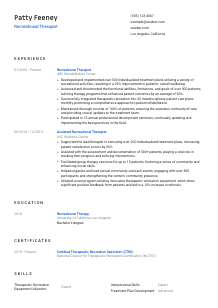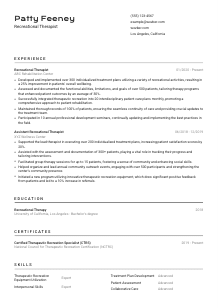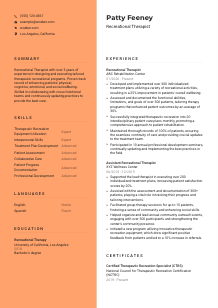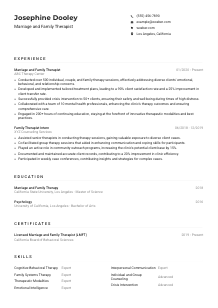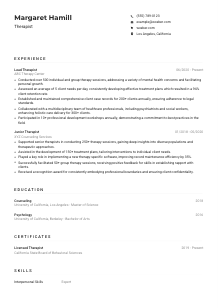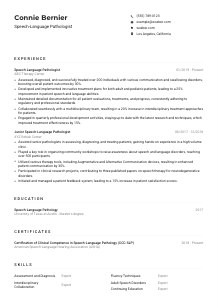Recreational Therapist Resume Example
Crafting leisurely activities, but your resume feels out of play? Dive into this Recreational Therapist resume example, choreographed with Wozber free resume builder. See how seamlessly you can infuse your therapeutic talents with job requirements, making your career path as engaging as the activities you organize!
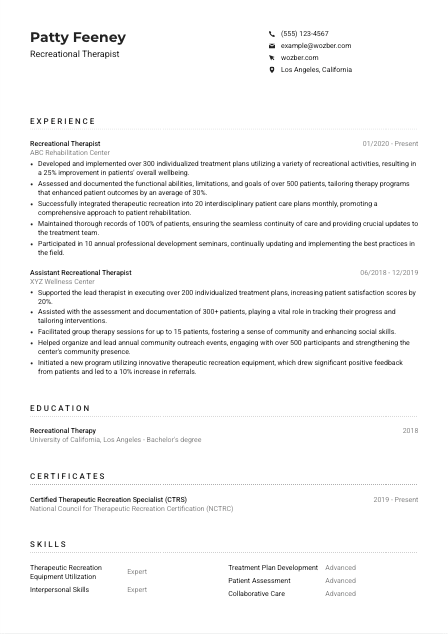
How to write a Recreational Therapist Resume?
Greetings to you, aspiring Recreational Therapist! In the realm of job hunting, standing out is not just about ticking boxes but embodying the qualities that set you apart. Your resume serves as your professional anthem, a mosaic of your skills and accomplishments. Harnessing the prowess of Wozber's free resume builder, this guide promises a journey of transforming your resume into a beacon for Recreational Therapist opportunities.
Together, let's sculpt a resume that not only aligns with your dream job's requirements but also dances to the rhythm of ATS optimization. The path to your next Recreational Therapist role starts here!
Personal Details
The 'Personal Details' section might seem straightforward, yet it's your resume's opening gambit. Carefully tailoring this section for the Recreational Therapist role sets the stage for a professional introduction that resonates with potential employers. Follow these steps to ensure your personal details are not just accurate, but a harmonious prelude to your qualifications and aspirations.
1. Lead with Your Name
Your name is your marquee, so let it shine. Opt for a clear, prominent font, making it slightly larger to ensure it captures attention. This is your headline, your personal brand, inviting the reader into your professional narrative.
2. Position Title Precision
Directly below your name, include the job title you're pursuing, "Recreational Therapist" in this case. This immediate alignment with the role crystalizes your career focus and ensure ATS algorithms and hiring managers recognize your intent at first glance.
3. Essential Contact Formats
Accuracy is key in your contact information. Double-check your phone number and opt for a professional email address format (e.g., firstname.lastname@email.com). This foundational accuracy paves a trustworthy path to your candidacy.
4. Location Synchronization
The specified job locale is Los Angeles, California. Mentioning your location as "Los Angeles, California" indicates your readiness and availability, minimizing any logistics concerns upfront.
5. Professional Profiles
Adding a LinkedIn profile or personal website, when relevant, can offer a deeper dive into your professional universe. Ensure they're current and reflective of your resume to maintain consistency and credibility.
Takeaway
Crafting the 'Personal Details' section with clarity and alignment to the Recreational Therapist role not only sets the professional tone but also articulates your readiness. These initial details act as your handshake, so make it firm, confident, and fitting to the role you aspire to secure.





Experience
For a Recreational Therapist, your 'Experience' section is your stage to showcase your career highlights and professional prowess. It's where you get to tell stories of how you've made a difference through your work. Let's refine this section to mirror the needs of your desired role, illustrating how each past role has been a step towards becoming the ideal Recreational Therapist.
- Developed and implemented over 300 individualized treatment plans utilizing a variety of recreational activities, resulting in a 25% improvement in patients' overall wellbeing.
- Assessed and documented the functional abilities, limitations, and goals of over 500 patients, tailoring therapy programs that enhanced patient outcomes by an average of 30%.
- Successfully integrated therapeutic recreation into 20 interdisciplinary patient care plans monthly, promoting a comprehensive approach to patient rehabilitation.
- Maintained thorough records of 100% of patients, ensuring the seamless continuity of care and providing crucial updates to the treatment team.
- Participated in 10 annual professional development seminars, continually updating and implementing the best practices in the field.
- Supported the lead therapist in executing over 200 individualized treatment plans, increasing patient satisfaction scores by 20%.
- Assisted with the assessment and documentation of 300+ patients, playing a vital role in tracking their progress and tailoring interventions.
- Facilitated group therapy sessions for up to 15 patients, fostering a sense of community and enhancing social skills.
- Helped organize and lead annual community outreach events, engaging with over 500 participants and strengthening the center's community presence.
- Initiated a new program utilizing innovative therapeutic recreation equipment, which drew significant positive feedback from patients and led to a 10% increase in referrals.
1. Dissect the Role
Thoroughly review the job description, noting key responsibilities and required skills. For instance, "developing and implementing individualized treatment plans" and "maintaining records" are central duties that should echo in your listed experiences.
2. Frame with Precision
Organize your experience in reverse chronological order, spotlighting your journey towards becoming a seasoned Recreational Therapist. Each entry should clearly state your job title, employer, and the dates of your tenure.
3. Tailored Achievements
Narrate your accomplishments with a focus on how they align with the Recreational Therapist role. Quantify successes, like "Developed over 300 individualized treatment plans, resulting in a 25% improvement in patients' overall wellbeing," to substantiate your impact.
4. Quantitative Proof
Use numbers and statistics to provide tangible evidence of your contributions. This might involve percentages highlighting patient improvement, the number of plans developed, or team projects led. Solid figures bring your narrative to life.
5. Relevance Reigns
Stick to experiences that directly speak to your capabilities as a Recreational Therapist. While diverse experiences add richness, ensure they're pertinent and showcase skills that complement the job's requirements.
Takeaway
Consider the 'Experience' section as your curated portfolio, a testament to your journey in the field of Recreational Therapy. Each entry is a testament to your readiness and capability. Articulate your path with clarity, ensuring your narrative resonates with the essence of a Recreational Therapist's role. This is your time to shine; let your experience trumpet your expertise.
Education
In the context of becoming a Recreational Therapist, your 'Education' section is more than a formality; it's the bedrock of your expertise. Let's sculpt this section to not only highlight your academic achievements but to also mirror the depth of your commitment to this field.
1. Highlight the Essentials
Begin with the cornerstone of your qualifications: "Bachelor's degree in Recreational Therapy, Therapeutic Recreation, or related field." This aligns directly with the job requirement, solidifying your foundational skill set.
2. The Simplicity of Structure
Maintain a clear, straightforward outline in this section: list each degree or certification with its field of study, awarding institution, and graduation date in a clean, easy-to-read format.
3. Degree Specificity
If the job explicitly requires a specific degree, make sure yours matches up. For example, your "Bachelor's degree in Recreational Therapy" directly matches the listed requirement, underlining your suitability for the role.
4. Coursework and Specializations
While your degree might cover the broader requirement, listing relevant coursework or specializations can further underscore your expertise and dedication to the field.
5. Beyond the Classroom
Participation in relevant clubs, organizations, or projects showcases your passion and engagement beyond academic requirements. Highlight these experiences if they enrich your profile as a Recreational Therapist.
Takeaway
Your 'Education' section is a testament to your preparedness and passion for the field of Recreational Therapy. By aligning your educational background with the job's requirements, you craft a narrative of readiness and dedication. Make this section a proud declaration of your academic journey, paving the way to your professional future.
Certificates
In the sphere of Recreational Therapy, certifications are more than accolades; they're demonstrations of your commitment to excellence and continuous learning. Structuring the 'Certificates' section effectively can significantly elevate your resume.
1. Key Certificate Highlight
Identify and showcase certificates that the job explicitly requires, such as the "Certified Therapeutic Recreation Specialist (CTRS) certification." Placement of this certification prominently positions you as an ideal candidate.
2. Pertinence and Precision
Focus on listing certifications that directly contribute to your qualifications for the Recreational Therapist role. This selective inclusion ensures that your resume is streamlined and targeted.
3. Chronological Clarity
For certificates with a validity period, including the date of achievement or renewal can be critical. It showcases your current competency and dedication to maintaining professional standards.
4. Continuous Improvement
The field of Recreational Therapy is ever-evolving. Highlight your commitment to staying abreast of the latest practices and techniques by continually updating and acquiring new certifications.
Takeaway
Let your 'Certificates' section be a powerful endorsement of your skills and commitment to professional growth. By intelligently selecting and presenting your certifications, you communicate a narrative of excellence and preparedness. Use this section to validate your prowess as a Recreational Therapist poised for impactful contributions.
Skills
The 'Skills' section of your resume is a critical showcase of the professional tools you wield. For a Recreational Therapist, this segment must be carefully curated to highlight both your technical and interpersonal capabilities. Let's navigate through maximizing this section's potential to align with your prospective role.
1. Dissect and Align
Start by parsing the job description for both explicit and implied skills. As a Recreational Therapist, including "Therapeutic Recreation Equipment Utilization" and "Interpersonal Skills", directly speaks to the needs of the role.
2. Prioritize and Position
Choose skills that directly correlate with the job requirements. Positioning the most relevant skills at the forefront ensures they capture the hiring manager's attention immediately.
3. Order and Organize
Balance hard skills with soft skills to present a holistic skill set. For instance, juxtaposing "Treatment Plan Development" with "Collaborative Care" showcases both your technical expertise and your ability to work within a team.
Takeaway
The 'Skills' section is your opportunity to crystallize your professional essence into a concise list that speaks volumes. Meticulous selection and strategic placement of skills invite the hiring manager to envisage you in the role, fulfilling and excelling in every aspect. Approach this section as a craftsman, selecting only the tools that best define your expertise as a Recreational Therapist.
Languages
In the global and diverse field of Recreational Therapy, the ability to speak multiple languages can significantly widen your professional appeal. Tailoring the 'Languages' section can add an invaluable dimension to your resume, showcasing your readiness to communicate effectively with a broader range of patients.
1. Job Compatibility Check
Firstly, examine the job listing for any preferred or required languages. Noting the need for "high proficiency in English" underscores its criticality for the role.
2. Prioritize and Highlight
List English at the top, marked as 'Native' or 'Fluent', to align with the job's prerequisites. This ensures that the main linguistic requirement is immediately noticeable.
3. Expand Your Linguistic Portfolio
Following the primary language, include other languages you are proficient in. This broadens your appeal and showcases a versatile skill set valuable in multicultural environments.
4. Honesty in Proficiency
Clearly define your level of proficiency using terms such as 'Fluent', 'Intermediate', and 'Basic'. Transparent indication builds trust and sets realistic expectations for your linguistic capabilities.
5. Role Relevance Reflection
Consider the scope and demographics of the role. If the position involves diverse patient interactions, highlighting additional languages could significantly bolster your candidacy.
Takeaway
Your linguistic proficiency is not merely a section on your resume; it's a demonstration of your ability to connect and communicate. Language skills can be a distinguishing factor, especially in roles that value diversity and inclusion. Play to this strength, showcasing your linguistic diversity as a bridge to building therapeutic relationships in the field of Recreational Therapy.
Summary
An engaging and well-crafted summary is like a window into your professional soul. For a Recreational Therapist, this section needs to distill your essence, blending your skills, experience, and passion into a compelling narrative. Let's explore how to tailor this segment to catch the eye and capture the imagination.
1. Comprehend and Condense
Begin by encapsulating the job description's core requirements. Use this understanding to sculpt a summary that foregrounds your alignment with these core competencies.
2. Initiate with Impact
Start with a strong, identity-affirming statement that lists your profession, years of experience, and key strengths, e.g., "Recreational Therapist with over 3 years of experience in designing tailored therapeutic recreational programs."
3. Highlight Your Harmony
Weave in your skills and achievements that speak directly to the job's needs, showcasing how your professional journey is a perfect match for the role.
4. Conciseness is King
Keep your summary focused and fluid—3-5 lines that entice the reader to delve deeper into your resume. This is your opening melody, a taste of your professional depths, not the entire concert.
Takeaway
Think of your summary as the prelude to your career symphony. It sets the tone, establishes the theme, and invites the audience on a journey. Crafting a summary that resonates with the heart of a Recreational Therapist role is your first step toward making a meaningful connection with potential employers. Let it sing with clarity, pitch with precision, and resonate with relevance.
Launching Your Recreational Therapist Journey
Congratulations! You've now unraveled the art of tailoring a resume to the nuanced needs of a Recreational Therapist role. Armed with these tools and insights, you're prepared to cast your professional net with precision and purpose. Remember, your resume is more than a document; it's a narrative, a testament to your journey and aspirations. Refine it, infuse it with your unique flair, and let it be your bridge to your next endeavor. The path you've charted is vibrant with promise.
Embrace it, and step forward with confidence. Your future as a Recreational Therapist shines bright. Use Wozber's free resume builder, its ATS-friendly resume template, and ATS resume scanner to ensure your document is not only visually appealing but also optimized for your success. The world awaits your talent—go forth and thrive!

- Bachelor's degree in Recreational Therapy, Therapeutic Recreation, or related field.
- Certified Therapeutic Recreation Specialist (CTRS) certification.
- Minimum of 2 years experience in a clinical or rehabilitative setting.
- Proficient in utilizing a variety of therapeutic recreation equipment and techniques.
- Strong interpersonal skills, with the ability to connect with patients of all ages and abilities.
- The role demands high proficiency in English.
- Must be located in Los Angeles, California.
- Develop and implement individualized treatment plans using a variety of recreational activities to improve patients' physical, cognitive, emotional, and social wellbeing.
- Assess patients' functional abilities, limitations, and goals to tailor therapy programs accordingly.
- Collaborate with interdisciplinary teams to integrate therapeutic recreation into overall patient care plans.
- Document patient progress, maintain records, and provide regular updates to the treatment team.
- Participate in continual professional development and stay updated on best practices in the field of recreational therapy.





